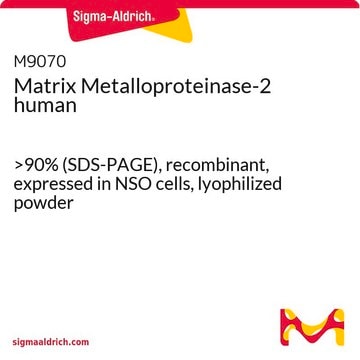SAE0077
MMP-9 human
recombinant, ≥1,300 pmol/min/μg, expressed in HEK 293 cells
Synonym(s):
GELBCLG4B, Gelatinase, Gelatinase B, MANDP2, MMP-9, Matrix Metalloproteinase-9, Type IV collagenase
About This Item
Recommended Products
biological source
human
Quality Level
recombinant
expressed in HEK 293 cells
Assay
95% (SDS-PAGE)
form
liquid
mol wt
calculated mol wt 76 kDa
observed mol wt 92 kDa (The protein migrates as a 92 kDa protein on SDS-PAGE due to glycosylation)
concentration
50-200 μg/mL
UniProt accession no.
application(s)
cell analysis
shipped in
dry ice
storage temp.
−20°C
Gene Information
human ... MMP(4318)
General description
Biochem/physiol Actions
MMP-9 is secreted from neutrophils, macrophages, and a number of transformed cells, and is the most complex family member in terms of domain structure and regulation of its activity.
Structurally, MMP9 maybe be divided into five distinct domains: a pro-domain which is cleaved upon activation, a gelatin binding domain consisting of three contiguous fibronectin type II units, a catalytic domain containing the zinc binding site, a proline rich linker region, and a carboxyl terminal hemopexin like domain.
Other Notes
Physical form
Storage Class Code
12 - Non Combustible Liquids
WGK
WGK 1
Flash Point(F)
Not applicable
Flash Point(C)
Not applicable
Certificates of Analysis (COA)
Search for Certificates of Analysis (COA) by entering the products Lot/Batch Number. Lot and Batch Numbers can be found on a product’s label following the words ‘Lot’ or ‘Batch’.
Already Own This Product?
Find documentation for the products that you have recently purchased in the Document Library.
Customers Also Viewed
Our team of scientists has experience in all areas of research including Life Science, Material Science, Chemical Synthesis, Chromatography, Analytical and many others.
Contact Technical Service








